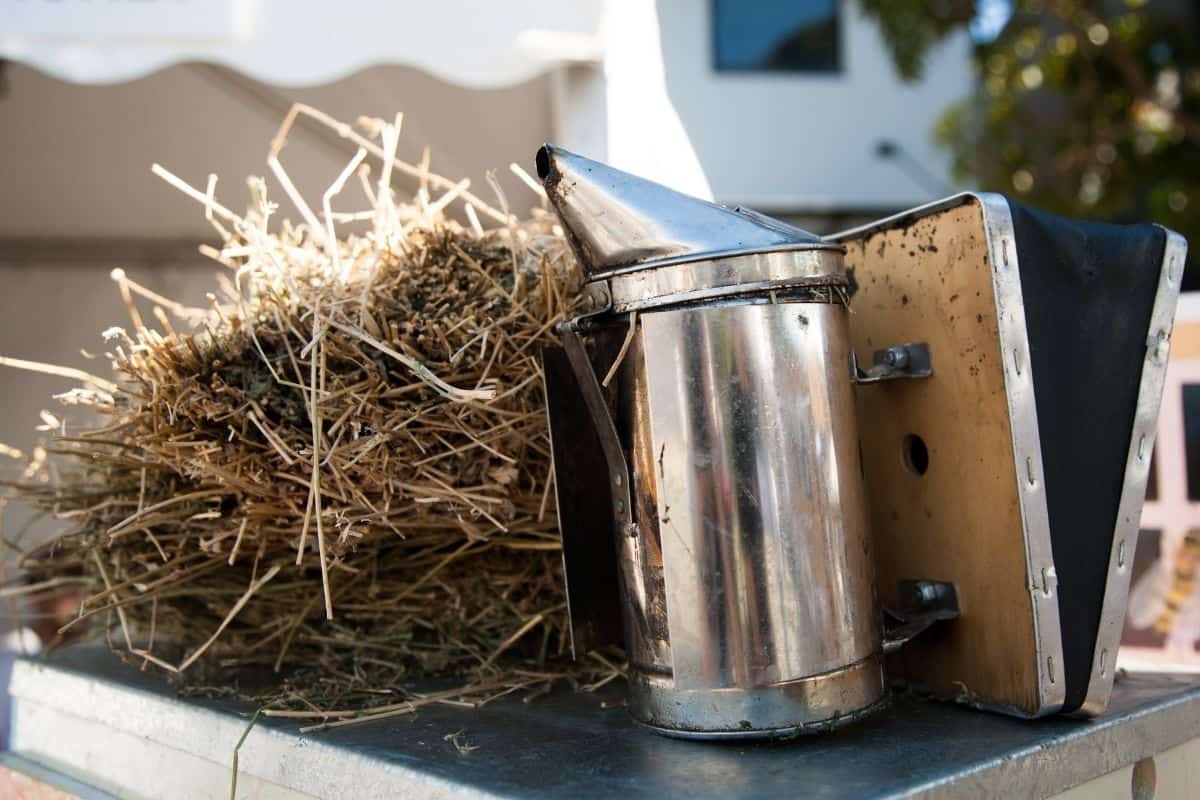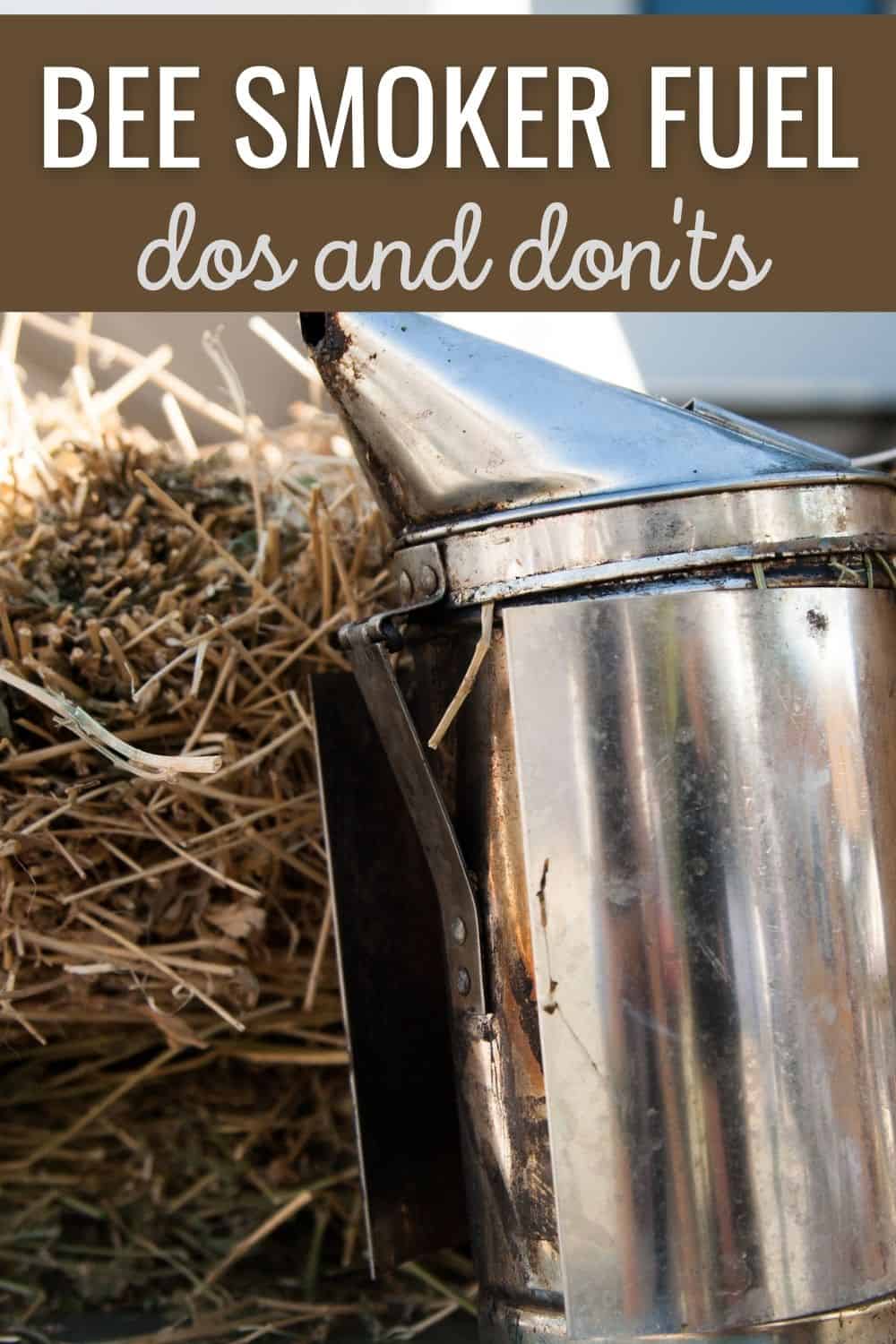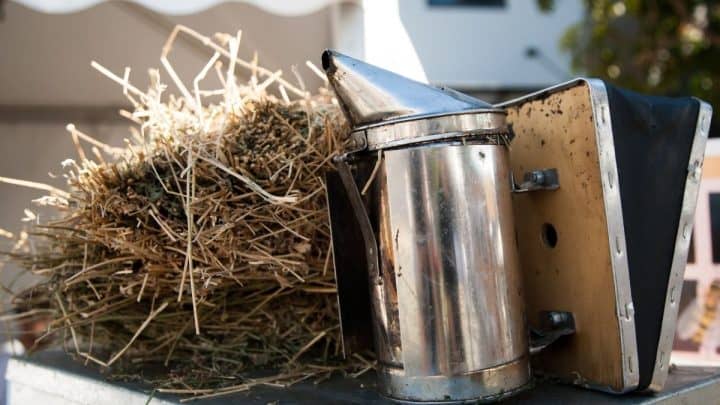A smoker is an indispensable piece of equipment for the beekeeper, and you should always have a lit smoker on hand before you open your hives to do any work. As a new beekeeper, you may wonder what you can and can’t use in your smoker to produce the smoke to keep your bees under control. We will cover the main fuels you should never use in a bee smoker, as well and some of the bee smoker fuel you CAN use!
You should never use wood, plastic products, rubber, paper, corrugated cardboard, or any synthetic product or products that contain adhesives as fuel in your bee smoker. The smoke can harm the bees, contaminate the honey and be detrimental to the health of the beekeeper.

Beekeeping can be a fairly technical hobby, requiring an understanding of the bees and how to keep the bees calm when working on the hive. The smoke emanating from your smoker can have the desired effect or serve to agitate the bees and even kill your bees if the wrong smoke is used.
What You Should Never Burn In Your Bee Smoker
The purpose of the smoke used in beekeeping is intended to calm the bees down and prevent them from becoming agitated when you open the hive to do maintenance or harvest the honey.
Bees are not tame animals, and beekeepers are only offering these wild animals a home conducive to the colony growing in size and producing honey. As beekeepers, we need to keep our interaction with the bees as natural as possible and mimic natural conditions when we work with the bees.
This strategy should include the smoke that we use from our smokers to calm the mood of a colony when we open the hive.
The intention of the fuel used in your smoker is to smolder rather than burn. Smoldering fuel produces better smoke than fuel that burns quickly with a lot of associated heat. We do not want a lot of heat from the smoker fuel, but rather lots of smoke from a low smolder instead of a quick burn!
Consequently, the choice of fuel for the smoker must be made with care to get the desired result and change the bees’ mood.
In bees’ natural environment, the smoke they would ordinarily encounter would be wood smoke, leaf litter smoke, or smoke from brush fires. As beekeepers, we need to find a smoke source that gives the type of burn we require and produce smoke as natural as possible for the bees.
One aspect that new beekeepers forget is that honey absorbs flavors very quickly, and the smoke used in your smoker can affect the flavor of the honey. This is why beekeepers puff the smoke across the top of the hive rather than down into the beehive.
The following items should never be used as fuel in your smoker either because they are not practical or produce smoke that is not good for the bees or the honey.
1. Do not use wood in your bee smoker
Wood is difficult to light in a bee smoker and will take too long to start smoldering and produce sufficient smoke quantities.
Twigs and small sticks should also not be used in a bee smoker. These small items tend to burn fast with a lot of heat and produce very little smoke. Using this fuel will require frequent restocking of the fuel in the smoker.
This smoker management takes time away from the work you are doing in the hive and keeps the hive open longer than necessary while you attend to the smoker.
2. Never use plastic products in your bee smoker
When plastic burns, it produces toxic fumes. These toxic fumes can kill the bees and contaminate the honey within the hive.
Not only is plastic smoke harmful to the bees, but it is also harmful to the beekeeper if the smoke and fumes are inhaled.
Plastic burns too quickly with too much heat, which, when combined with the toxic smoke, makes any plastic product unsuitable as a fuel for your bee smoker.
3. Do not use rubber in your bee smoker
Rubber is generally a natural product, but it produces an acrid black smoke that is not suitable for use in beekeeping.
The smoke leaves a tar-like residue in your smoker and the hive when you puff rubber smoke over the hive. This smoke would certainly contaminate the honey and could also cause your bees to abandon the hive.
4. Paper is not a good bee smoker fuel
Certain paper can be used in a smoker, but since you are never sure how the paper has been treated, it should not be considered as good fuel for a beekeeper to use.
White paper has been treated with bleach to whiten the paper, and this bleach impregnates the paper and releases toxins when burned.
Printed paper has ink embedded in the paper, releasing toxic chemicals such as arsenic when the paper is burned. Thus, any printed paper, glossy, white, or colored paper, should never be used as smoker fuel when working with bees.
5. Do not use corrugated cardboard in your bee smoker
Cardboard can be used in your bee smoker and is a fuel that smolders well. However, in my experience, cardboard smoke can be a little acrid, and it burns your eyes if the wind changes direction and blows it into your face.
Corrugated cardboard is different from plain cardboard and should never be used in your smoker. Corrugated cardboard is a layer of corrugated cardboard sandwiched between two flat layers of cardboard, all held together with adhesive.
The adhesive used to glue the cardboard together in the manufacture of corrugated cardboard produces a harsh smoke when burned that is not good for the bees or the honey.
What Is The Best Bee Smoker Fuel?
So, what fuel SHOULD you use in your bee smoker?
We have covered the fuels that you should never use in your bee smoker, so we will give you some alternative ideas of what you should be looking to burn in your smoker.
Natural materials that smolder well without much heat are ideal fuel sources for your bee smoker. These fuels can include the following.
- Pine needles. Pine needles work very well as fuel for a bee smoker. The pine needles contain resin and oils that smolder very well, and the smoke produced is not acrid.
- Dried herbs. Dried herbs make for an aromatic smoke that is non-toxic to bees.
- Dried citrus peel. The oils in the dried citrus peel smolder very well in a bee smoker.
- Dried grass. This includes lawn clipping and hay and straw.
- 100% cotton fabric. Old t-shirts or blue jeans made from 100% cotton make a good smoker fuel when rolled up.
- Untreated burlap. Burlap or hessian that is untreated makes a great natural bee smoker fuel.
- Dry horse manure. This is my favorite smoker fuel. It smokes well with little heat and is all-natural.
- Commercial smoker pellets. Commercial pellets can be purchased that are formulated to be safe for you and your bees.
Conclusion
Many fuels can be used in a bee smoker, making it easy to find an alternative to potentially harmful products to burn in your smoker.
Any synthetic or manmade products should be avoided in your smoker, as should any petro-chemical fuels like kerosene or gasoline. Your smoker fuel should be as natural as possible and produce good, white smoke with as little heat as possible. Never use a fuel that produces black smoke.
Remember that you will be exposed to the smoke from your bee smoker, so never use smoke that will be harmful to you, and it should be safe for the bees too!




Quick Introduction To Beekeeping
Wednesday 3rd of August 2022
[…] Bee Smoker Fuel Tips: 5 Things You Should Not Put in a Bee Smoker (And 8 You Should!) […]
Teresa L Fikes
Monday 18th of October 2021
This is a very informative article. There were several things mentioned that I wouldn't have even thought about. Thanks for sharing